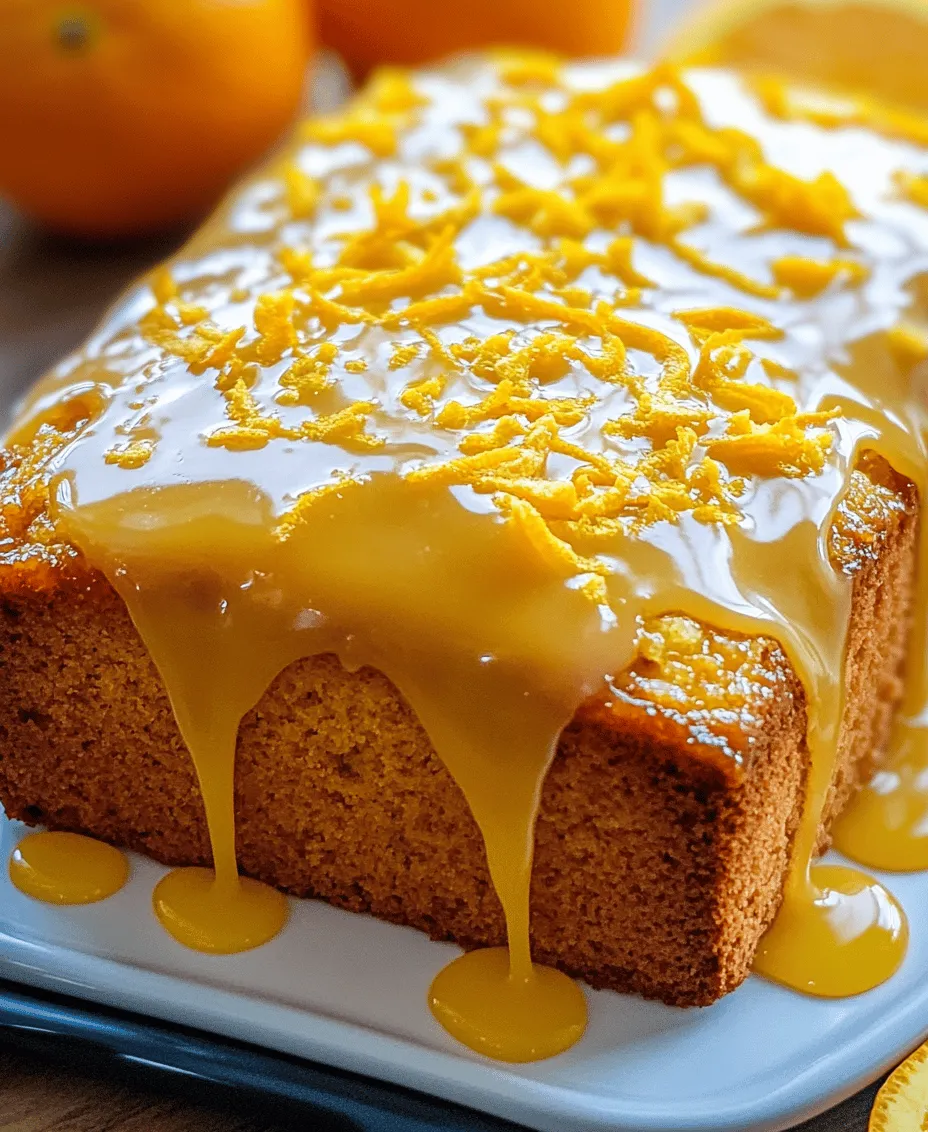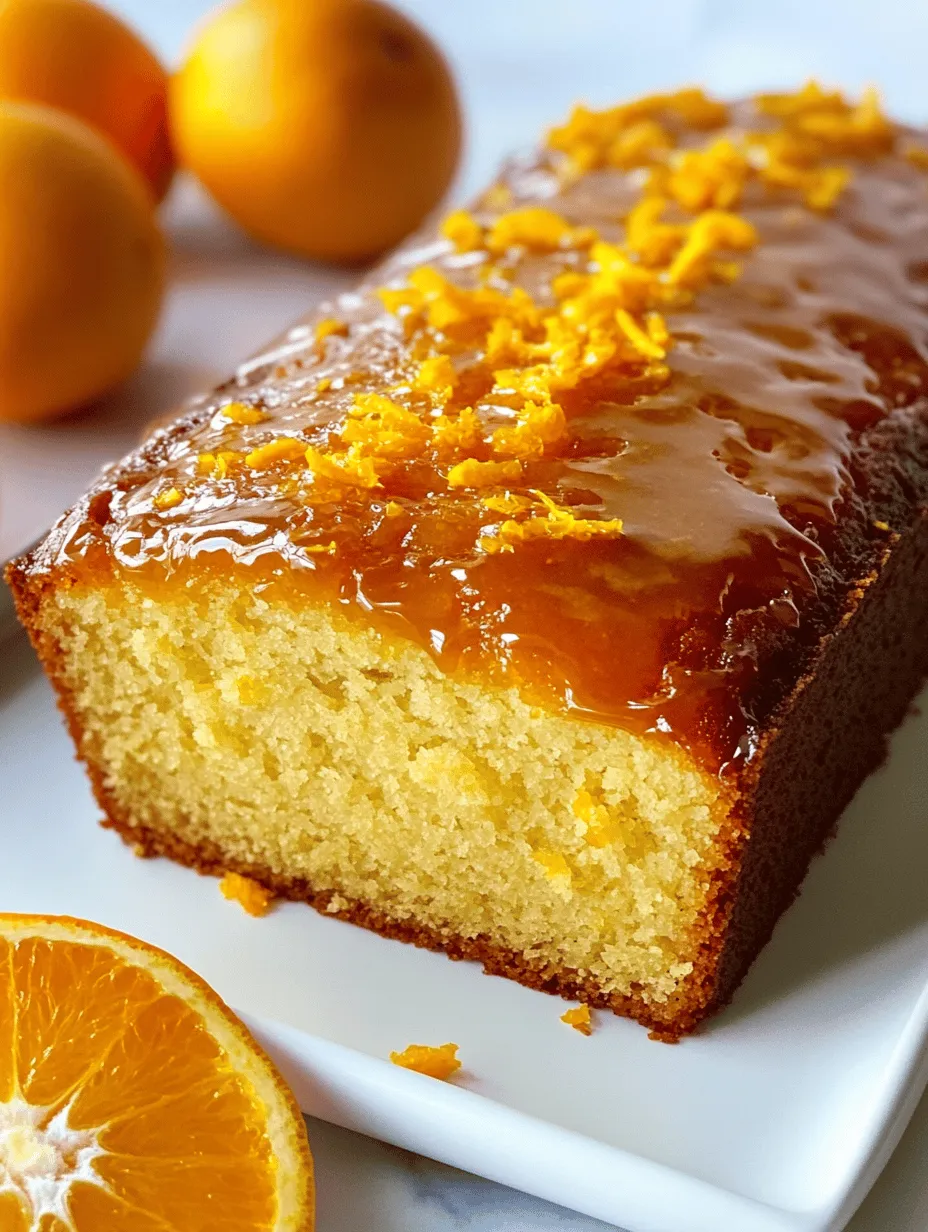Introduction
Loaf cakes have become a beloved staple in the world of baking, treasured for their simplicity, versatility, and delightful flavors. These moist, tender cakes can be enjoyed as breakfast, a snack, or dessert, making them a favorite choice for many home bakers. Among the myriad of loaf cake options available, the “Zesty Delight: Orange Loaf Cake” stands out as a refreshing and vibrant dessert that captures the essence of citrus in every slice.
This delightful orange loaf cake is not just about its appealing appearance; it offers a burst of citrus flavor that tantalizes the taste buds. The zesty notes of fresh orange zest and juice infuse the cake with a bright, uplifting aroma that fills your kitchen as it bakes. Its moist texture, achieved through a careful balance of ingredients, ensures that each bite is a satisfying experience, making it a perfect treat for any occasion.
Whether you’re hosting a casual gathering, celebrating a special milestone, or simply looking for a sweet indulgence during the week, this orange loaf cake is a versatile option that can be dressed up or down. Serve it plain for a comforting snack, or drizzle it with a sweet glaze for an elegant dessert suitable for festive celebrations. The adaptability and charm of this cake make it a delightful addition to any recipe collection.
Understanding the Ingredients
To create the perfect Zesty Delight: Orange Loaf Cake, understanding the role of each ingredient is crucial. Each component plays a specific function that contributes to the cake’s overall flavor, texture, and appearance. Let’s take a closer look at the key ingredients that make this cake so special:
– All-Purpose Flour: The backbone of any cake, all-purpose flour provides the necessary structure and texture. Its blend of protein helps create the cake’s crumb, ensuring it holds together beautifully while still remaining tender.
– Granulated Sugar: This ingredient not only adds sweetness but also contributes to the cake’s moisture. Sugar interacts with the other ingredients during baking, helping to create a soft, fluffy texture that melts in your mouth.
– Baking Powder and Baking Soda: These leavening agents are essential for achieving a light, airy loaf. Baking powder works to provide lift during baking, while baking soda helps balance acidity, especially when combined with the citrus elements in the recipe.
– Unsalted Butter: Rich and flavorful, unsalted butter enhances the overall taste of the cake. It also plays a vital role in creating a moist texture and helps in the creaming process, which is key to achieving the right consistency.
– Eggs: Eggs act as a binding agent, holding all the ingredients together while adding moisture. They also contribute to the cake’s structure and richness, ensuring a satisfying bite.
– Orange Zest and Juice: The star ingredients of this recipe, fresh orange zest and juice, infuse the cake with vibrant citrus flavor and aroma. Zest contains essential oils that provide a concentrated burst of orange flavor, while the juice adds moisture and a touch of acidity that balances the sweetness.
– Vanilla Extract: A classic addition to most baked goods, vanilla extract enhances the overall flavor profile of the cake, complementing the citrus notes and adding depth to the taste.
– Powdered Sugar: Used for the glaze, powdered sugar brings sweetness and a smooth finish to the cake. When mixed with orange juice or water, it creates a luscious topping that adds a finishing touch to the loaf.
Step-by-Step Instructions for Baking the Orange Loaf Cake
Now that you have a solid understanding of the ingredients, it’s time to dive into the baking process. Here’s a comprehensive guide to ensure your Zesty Delight: Orange Loaf Cake turns out perfectly every time.
Preparing the Oven and Pans
Before you begin mixing your ingredients, it’s essential to preheat your oven. Set it to 350°F (175°C) to ensure it’s at the right temperature when your batter is ready to go in. Preheating is crucial because it helps the cake rise properly and develop a nice golden crust.
Next, prepare your loaf pan. You can either grease it with unsalted butter or cooking spray to prevent sticking or line it with parchment paper for an easier release. If you choose the parchment method, make sure to leave some overhang to facilitate lifting the cake out once it’s baked. Proper preparation of the pan ensures a smooth removal and maintains the integrity of your loaf.
Mixing the Dry Ingredients
In a medium-sized mixing bowl, start by whisking together the dry ingredients. Combine 1 ½ cups of all-purpose flour, 1 teaspoon of baking powder, ½ teaspoon of baking soda, and a pinch of salt. Whisking these ingredients together is important, as it helps to evenly distribute the leavening agents and ensures that no clumps remain. Once mixed, set this bowl aside; you’ll incorporate it into the wet ingredients later.
Creaming Butter and Sugar
In a large mixing bowl, add ½ cup of unsalted butter that has been softened to room temperature, along with 1 cup of granulated sugar. Using an electric mixer, beat the butter and sugar together on medium speed until the mixture becomes light and fluffy. This process, known as creaming, is vital as it introduces air into the batter, which contributes to the cake’s light and delicate texture.
Aim for a creamy consistency, where the mixture has doubled in volume and appears pale in color. This step usually takes about 3 to 5 minutes. If necessary, scrape down the sides of the bowl to ensure all the butter and sugar are evenly mixed.
Incorporating Eggs and Flavorings
Once the butter and sugar are creamed together, it’s time to add the eggs. Add 2 large eggs, one at a time, mixing well after each addition. This allows the eggs to emulsify with the butter-sugar mixture, creating a smooth batter. Follow up by adding the zest of one large orange (about 1 tablespoon) and ⅓ cup of fresh orange juice, along with 1 teaspoon of vanilla extract.
Mix until just combined. Be careful not to overmix at this stage, as this can lead to a denser cake. The batter should be cohesive and slightly thick, with a delightful aroma of citrus filling the air.
With the initial steps complete, you are well on your way to creating a moist and flavorful orange loaf cake that is sure to impress. Stay tuned for the next part of the recipe, where we’ll complete the mixing process, bake the cake, and discuss the all-important glazing technique that adds the final touch to this zesty delight.

The Significance of Adding Eggs One at a Time and Mixing Thoroughly
When making the perfect Orange Loaf Cake, the incorporation of eggs is a crucial step that shouldn’t be overlooked. Adding eggs one at a time allows for better emulsification, which creates a more stable batter. Each egg should be mixed in thoroughly before adding the next, as this ensures that the fats and liquids in the batter are well combined. This process not only improves the texture of the cake but also contributes to a more uniform crumb structure. Each egg adds moisture and richness, which is essential for a loaf cake that is both flavorful and tender.
How Orange Zest and Vanilla Extract Elevate the Flavor
The real magic of this Orange Loaf Cake comes from the vibrant orange zest and the subtle depth of vanilla extract. Orange zest—the outer peel of the orange—contains essential oils that provide a concentrated burst of citrus flavor, enhancing the overall taste profile of the cake. When combined with the warmth of vanilla extract, the aroma becomes irresistible, making each bite a delightful experience. Together, these ingredients create a harmonious balance, elevating the cake from a simple dessert to a standout centerpiece.
Combining Wet and Dry Ingredients
Once your eggs are fully incorporated, it’s time to combine the wet and dry ingredients. This step is essential for establishing the right texture. Start by sifting together your dry ingredients—flour, baking powder, and a pinch of salt—into a separate bowl. This not only removes lumps but also aerates the flour, which is vital for a light and fluffy cake. In another bowl, combine your wet ingredients, including the creamed butter and sugar mixture, eggs, orange juice, and zest.
When you’re ready to combine the two mixtures, pour half of the dry ingredients into the wet mixture and stir gently. Then, add half of the remaining wet ingredients. Repeat this process, alternating between the dry and wet ingredients. This technique helps maintain the integrity of the batter while ensuring everything is evenly mixed.
Techniques for Mixing Batter to Avoid Over-Mixing
Mixing the batter is a delicate task. Over-mixing can lead to a dense and tough cake due to the development of gluten. To avoid this, mix the batter until just combined. It’s okay if there are a few small lumps remaining; they will often disappear during baking. Use a rubber spatula or wooden spoon, and fold the batter gently rather than stirring vigorously. This technique preserves the air pockets created during the creaming stage, leading to a lighter loaf.
The Importance of Alternating Dry and Wet Ingredients
Alternating between dry and wet ingredients serves a functional purpose beyond just mixing. This method helps to maintain the right moisture level in the batter, preventing it from becoming too wet or dry. By adding the dry ingredients first, you provide a buffer for the wet ingredients to be absorbed gradually, resulting in a smoother batter. This careful balance is vital for achieving that perfect loaf cake texture.
Pouring and Baking the Batter
Once your batter is ready, it’s time to pour it into the prepared loaf pan. Use a spatula to transfer the batter, ensuring you scrape down the sides of the bowl to include all of the mixture. Pour the batter into the center of the loaf pan, and use the spatula to gently smooth the top, making sure it’s evenly distributed.
Tips for Pouring Batter into the Pan and Smoothing the Top
To achieve the best results, ensure your loaf pan is well-greased or lined with parchment paper. This prevents sticking and allows for easy removal once baked. When smoothing the top, it’s helpful to tap the pan gently against the countertop to release any air bubbles trapped in the batter. This simple technique can prevent unsightly holes in the finished cake.
Baking Time and How to Check for Doneness
The baking time for your Orange Loaf Cake will typically range from 45 to 60 minutes at 350°F (175°C). However, every oven is different, so it’s essential to keep an eye on your cake. A good way to check for doneness is to insert a toothpick into the center of the loaf. If it comes out clean or with just a few crumbs attached, your cake is ready. If the toothpick has wet batter on it, allow the cake to bake for a few more minutes before checking again.
Cooling and Glazing the Cake
Once your cake is baked to perfection, it’s vital to allow it to cool correctly. Let it cool in the pan for about 10–15 minutes. This cooling period helps the cake set and reduces the risk of it breaking when you transfer it to a wire rack. After cooling slightly, carefully remove the cake from the pan and let it cool completely on the wire rack.
Why Cooling in the Pan is Essential Before Transferring to a Wire Rack
Cooling in the pan allows the cake to firm up, making it easier to handle. If you try to remove the cake while it’s still too warm, it might crumble or lose its shape. Patience is key in this step; letting your cake cool properly enhances its flavor and texture, ensuring a delightful eating experience.
Instructions for Creating the Glaze and Achieving the Right Consistency
To add a finishing touch to your Orange Loaf Cake, prepare a simple glaze. In a bowl, combine powdered sugar with a few tablespoons of freshly squeezed orange juice until you reach your desired consistency. The glaze should be pourable but not too runny; it should coat the back of a spoon. If the glaze is too thick, add a little more juice; if too thin, add more powdered sugar. Drizzle the glaze over the cooled cake, allowing it to drip down the sides for a beautiful presentation.
Serving Suggestions for the Zesty Delight: Orange Loaf Cake
Your Zesty Delight: Orange Loaf Cake is perfect for various occasions, whether enjoyed as a delightful breakfast treat, an afternoon snack, or a dessert after dinner. Pair it with a steaming cup of coffee or a refreshing cup of tea. The citrus notes complement the warmth of these beverages beautifully.
Ideal Pairings for the Loaf Cake
For an added touch, serve slices of the cake alongside fresh fruit, such as berries or citrus segments, which can enhance the overall flavor profile. If you want to elevate the experience, consider a dollop of whipped cream or a scoop of vanilla ice cream on the side.
Presentation Ideas for Serving at Gatherings
When serving your Orange Loaf Cake at gatherings, consider garnishing it with additional orange zest or a few slices of orange on top for visual appeal. A pretty cake stand can also elevate the presentation, making it a focal point on your dessert table.
Suggestions for Storing Leftover Cake to Maintain Freshness
To keep any leftover cake fresh, store it in an airtight container at room temperature for up to three days. For longer storage, you can wrap the cake tightly in plastic wrap and freeze it for up to three months. Thaw it in the refrigerator overnight when you’re ready to enjoy it again.
Nutritional Information
Understanding the nutritional profile of your Orange Loaf Cake can help you make informed choices.
Overview of the Nutritional Benefits of Key Ingredients
Oranges are a great source of vitamin C and antioxidants, promoting good health. The whole eggs in the recipe provide protein and essential fatty acids, while the butter adds necessary fats for flavor and texture. Using whole wheat flour can increase the fiber content, making it a more nutritious option.
Discussion on Portion Control and Serving Sizes
A standard serving size for this loaf cake is about one slice, which is typically 1/8 of the loaf. This keeps the caloric intake moderate, allowing you to enjoy the cake guilt-free.
Caloric Breakdown per Slice and Overall Health Considerations
On average, one slice of Orange Loaf Cake contains around 200-250 calories, depending on the specific ingredients used. Being mindful of portion sizes and serving it with fresh fruit can balance the sweetness and contribute to a healthier dessert option.
Celebrating Citrus: The Appeal of Orange in Baking
Oranges have a rich history in culinary practices, dating back to ancient times. Their bright flavor and vibrant color have made them a favorite choice for both sweet and savory dishes across various cuisines.
Brief History of Oranges in Culinary Practices
Originally cultivated in Southeast Asia, oranges have traveled the world, becoming a staple in many cultures. From Moroccan tagines to Italian desserts, citrus flavors add brightness and complexity to a variety of dishes, showcasing the versatility of this fruit.
The Significance of Citrus Flavors in Various Cuisines
In baking, citrus fruits like oranges are prized for their ability to enhance flavors and provide a refreshing contrast to rich ingredients. They play a pivotal role in balancing sweetness and acidity, making them ideal for dessert recipes like our Orange Loaf Cake.
How the Addition of Oranges Can Enhance Both Sweet and Savory Dishes
Beyond baking, oranges can elevate salads, sauces, and marinades with their zesty brightness. This adaptability makes them a beloved ingredient in kitchens around the globe, encouraging cooks to experiment with new flavor combinations.
Conclusion
The Zesty Delight: Orange Loaf Cake is not just a recipe; it embodies the joy of baking and the refreshing taste of citrus. Easy to make and versatile for any occasion, this loaf cake dazzles with its vibrant flavors and delightful texture. Whether served at a casual family gathering or a festive celebration, it brings a sense of warmth and togetherness.
Embrace the art of baking and let the delightful aroma of oranges fill your home. This cake not only satisfies sweet cravings but also inspires creativity in the kitchen. So, gather your ingredients, follow the steps, and indulge in the joy of baking—your taste buds will thank you!



